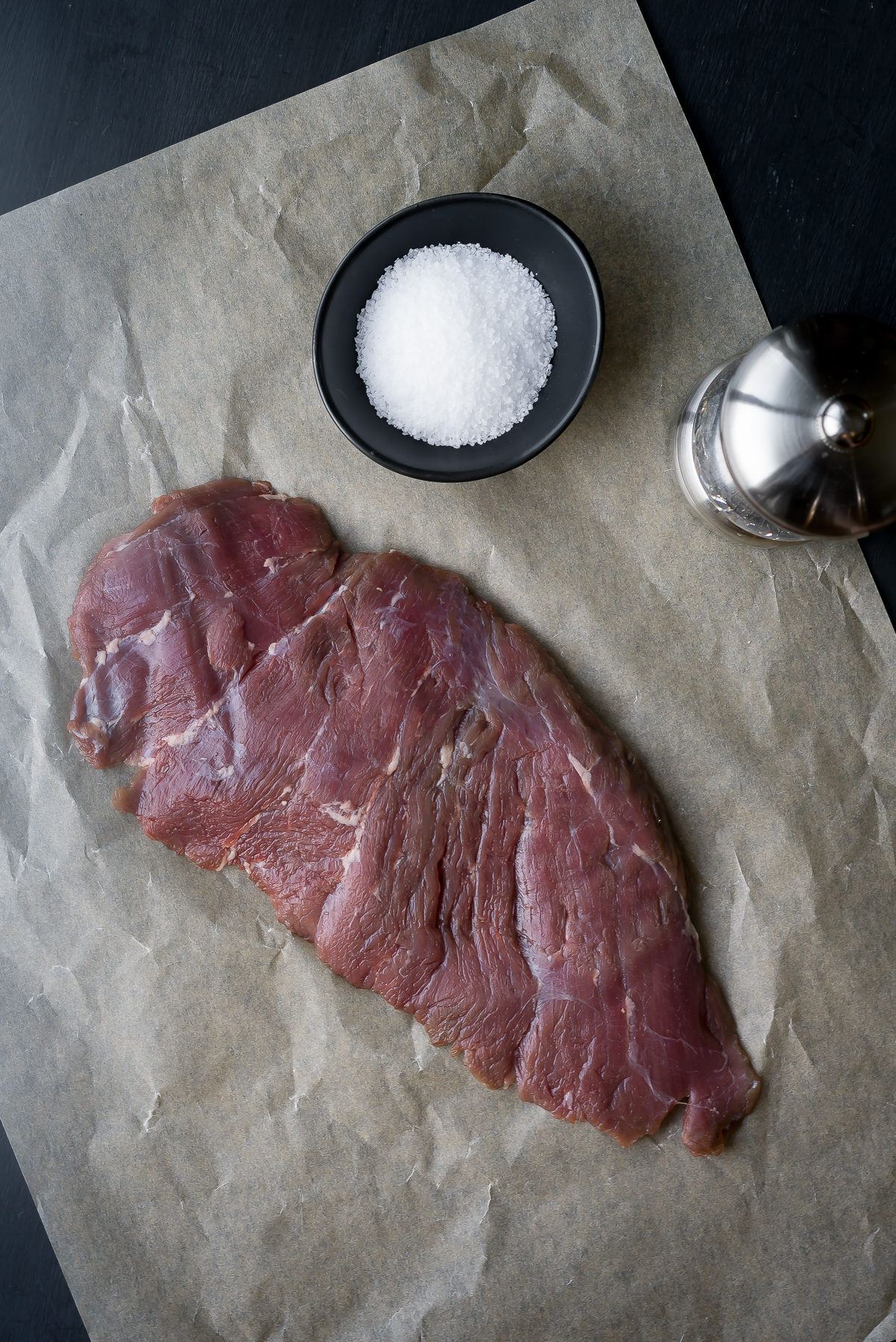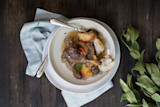
Prep time
30 minutes
Cook time
3 hours
Course
Main
Skill level
Intermediate
Season
Fall, Winter
Serves
4
When the weather starts to dip, I love this hearty dish highlighting an under-appreciated cut of meat: the brisket. This recipe turns the humble braise into a special dinner. After hours of cooking, the meat becomes infused with the sweet caramelized flavor of the red onions, which perfectly balance to the acidity of the balsamic vinegar. Those liquids reduce into a full-bodied sauce to spoon over the fork-tender meat when ready to serve.
Most people associate brisket with smoked barbecue beef, but you can certainly take the same cut off of a deer. The brisket is the thin “breast” meat covering the chest. This cut is very lean and consists of long muscle fibers and connective tissue that can be pretty tough and dry. Braising in the oven at a lower temperature for a long period of time works to break down those fibers, while the liquids help give it moisture and flavor.
Because the fibers run across the width of the meat, it’s important to cut against the grain when ready to serve. This will break them up and they should fall apart easily with a fork. You can take this a step further by roughly chopping it up it for sandwiches and layering it with the caramelized red onions.
If you didn’t save the brisket, a good substitute is any roast from the hind leg, shoulder, or even the neck. If you decide to go with a more dense cut, you might need to use a roasting pan (covering it with foil) and double the amount of liquids to keep it from drying out. The cooking time will also increase.
Ingredients
- 1½–2 lbs. venison brisket (substitute with roast, shoulder, or neck)
- Salt and pepper
- 2 red onions, sliced into ¼” rings
- 2 tsp. sugar
- 6 cloves of garlic, roughly chopped
- 1 cup balsamic vinegar
- 2 cups venison or beef stock, plus more as needed
- A few sprigs of thyme
- Bay leaf
- Oil for cooking
Also works with
Preparation
- Heat oven to 300°F.
- Pat the brisket dry and season generously with salt and pepper. For best results, do this step in advance (up to 24 hours). Before cooking, be sure to pull it out of the fridge and let it come to room temperature.
- In a large Dutch oven or heavy pot with lid, heat 1 to 2 tablespoons of oil over medium-high heat. Once hot, brown the brisket on each side (working in batches if it’s cut in two pieces). Remove and set aside on a plate.
- Reduce the heat to medium-low. If your pot was smoking, let it cool down for a minute. Add an additional tablespoon stir in the red onions. Allow them to cook, stirring occasionally for about five minutes. When the onions are beginning to soften, sprinkle in the sugar and stir. At this point the onions should just start to caramelize, and this is when you will add in the garlic. Cook garlic until fragrant, which is about 30 seconds to one minute.
- Deglaze the pot by pouring in the balsamic vinegar, scraping up bits at the bottom. Turn the heat off and let liquids boil for a minute, allowing the onions to soak up the juices. Add the stock, thyme, and bay leaf. Nestle the brisket in the onions until partly submerged and cover the pot with lid.
- Transfer to the oven and cook for approximately 2½ to 3 hours or more. Half way through you can check the meat, basting it with the liquid and adding a splash of stock if it seems to be drying out. The meat will be ready to serve when it begins to shred apart when pulled with a fork.
- Slice the brisket against the grain and serve with the reduced sauce and caramelized red onions.
Balsamic Braised Venison

Prep time
30 minutes
Cook time
3 hours
Course
Main
Skill level
Intermediate
Season
Fall, Winter
Serves
4
When the weather starts to dip, I love this hearty dish highlighting an under-appreciated cut of meat: the brisket. This recipe turns the humble braise into a special dinner. After hours of cooking, the meat becomes infused with the sweet caramelized flavor of the red onions, which perfectly balance to the acidity of the balsamic vinegar. Those liquids reduce into a full-bodied sauce to spoon over the fork-tender meat when ready to serve.
Most people associate brisket with smoked barbecue beef, but you can certainly take the same cut off of a deer. The brisket is the thin “breast” meat covering the chest. This cut is very lean and consists of long muscle fibers and connective tissue that can be pretty tough and dry. Braising in the oven at a lower temperature for a long period of time works to break down those fibers, while the liquids help give it moisture and flavor.
Because the fibers run across the width of the meat, it’s important to cut against the grain when ready to serve. This will break them up and they should fall apart easily with a fork. You can take this a step further by roughly chopping it up it for sandwiches and layering it with the caramelized red onions.
If you didn’t save the brisket, a good substitute is any roast from the hind leg, shoulder, or even the neck. If you decide to go with a more dense cut, you might need to use a roasting pan (covering it with foil) and double the amount of liquids to keep it from drying out. The cooking time will also increase.
Ingredients
- 1½–2 lbs. venison brisket (substitute with roast, shoulder, or neck)
- Salt and pepper
- 2 red onions, sliced into ¼” rings
- 2 tsp. sugar
- 6 cloves of garlic, roughly chopped
- 1 cup balsamic vinegar
- 2 cups venison or beef stock, plus more as needed
- A few sprigs of thyme
- Bay leaf
- Oil for cooking
Also works with
Preparation
- Heat oven to 300°F.
- Pat the brisket dry and season generously with salt and pepper. For best results, do this step in advance (up to 24 hours). Before cooking, be sure to pull it out of the fridge and let it come to room temperature.
- In a large Dutch oven or heavy pot with lid, heat 1 to 2 tablespoons of oil over medium-high heat. Once hot, brown the brisket on each side (working in batches if it’s cut in two pieces). Remove and set aside on a plate.
- Reduce the heat to medium-low. If your pot was smoking, let it cool down for a minute. Add an additional tablespoon stir in the red onions. Allow them to cook, stirring occasionally for about five minutes. When the onions are beginning to soften, sprinkle in the sugar and stir. At this point the onions should just start to caramelize, and this is when you will add in the garlic. Cook garlic until fragrant, which is about 30 seconds to one minute.
- Deglaze the pot by pouring in the balsamic vinegar, scraping up bits at the bottom. Turn the heat off and let liquids boil for a minute, allowing the onions to soak up the juices. Add the stock, thyme, and bay leaf. Nestle the brisket in the onions until partly submerged and cover the pot with lid.
- Transfer to the oven and cook for approximately 2½ to 3 hours or more. Half way through you can check the meat, basting it with the liquid and adding a splash of stock if it seems to be drying out. The meat will be ready to serve when it begins to shred apart when pulled with a fork.
- Slice the brisket against the grain and serve with the reduced sauce and caramelized red onions.





Reviews